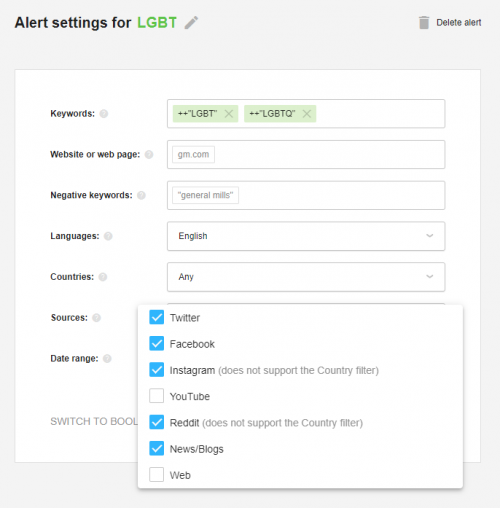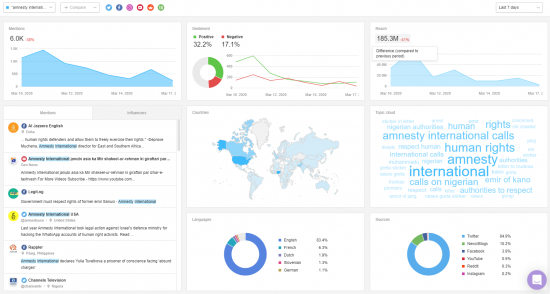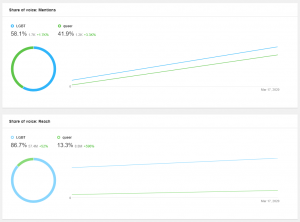How to do market research with social listening: a step-by-step guide
Social media is one of the simplest and most accessible ways to connect to your audience. Chances are your nonprofit already uses social media to update your followers on the latest news, encourage them to contribute to your cause, and interact with them. But are you using social media to gain valuable data insights for your nonprofit?
Every day people share their life events, opinions, and thoughts online — 2.96 billion people to be exact. This info could be directly related to your organization and its mission or not, whatever your goals and objectives are. By looking at large sets of social media data you can identify trends common for your audience and niche. This is the general goal of using social listening for market research.
Of course, when we talk about nonprofit marketing, we are not actually researching “the market”. Market research for nonprofits can take forms of researching your cause and how it’s discussed in media and online, looking into social data from your beneficiaries, finding influential voices to cooperate with and so on.
In this blog post, I want to go through the process of building a social listening strategy dedicated to market research for nonprofits. To illustrate each step of the process, I turned to my own experience of using social listening as an LGBTQ+ activist. So, without further ado, let’s dive in!
Step 1: Define your goals
As I already mentioned above, nonprofits’ reasons to do market research on social may differ from business reasons. Here are some common goals nonprofits can have when using social listening for market research:
- Find out more about the issue you’re tackling
- Learn about your beneficiaries
- Identify your allies
- Find influential voices to promote your message
- Learn what motivates your supporters to take action
Sometimes you come into market research with a clear goal in mind, for example, to find out how people based in the UK talk about poverty in rural areas. Other times it might be hard to determine what exactly you should research.
In this case, it’s a good practice to look at your mission statement. Your marketing and public relations effort should generally be tied to your mission, so look at it and ask yourself, how you can accomplish these goals by using social listening.
When you’re establishing your goals, it’s important to remember your stakeholders. Nonprofit organizations can have many stakeholders such as volunteers, donors, sponsors, employees, and beneficiaries. Social media data can be helpful to improve your relationships with any of them.
To give you an example, the organization I volunteer for organizes educational and cultural events on issues of gender and sexuality. Our mission is to educate people and contribute to decreasing the level of sexism, homophobia, and other types of discrimination in Belarusian society.
With social listening, one of my goals was to see how people are talking about LGBTQ+ people online, see how much people are aware of LGBTQ+ issues, and what are the feelings around them.
Step 2: Choose a tool
Now that you know your goals, you should consider what tools you are going to use to do market research. You can’t really collect and analyze social media data manually: social media platforms simply do not give you the ability to do it. Luckily, many social listening tools have nonprofit programs that give you access either for free or at a significantly reduced price.
Before you settle on a tool you need to choose your priorities. Here are some questions to ask yourself:
- Do you want to focus on specific platforms? Some tools prioritize one platform such as Tweetdeck for Twitter, others want to cover as much online space as possible, for example, Awario.
- Do you need any specific analytics? For example, if you want to find out how your target audience feels about the issue you are tackling, you’ll probably need sentiment analysis, if your organization works internationally, you might need location data, and so on.
- Are the tool’s settings flexible enough? Does the tool allow you to create complicated search queries in case you need to collect data on a very specific issue?
Protip: Boolean search is the feature to look for when it comes to getting the most precise data. It allows you to create complicated search queries for those cases when you need to specify a lot of keyword combinations or eliminate many unrelated results.
- Does the tool offer a nonprofit program or discounts for nonprofits?
These questions should help you narrow down a long list of social listening tools. The good news is that some of them are free, and most of them offer either free versions or free trials so you can try them out without any financial commitments. This article gives you a nice run-down of tools to check out.
I’m a part of the Awario team, so I get to use the tool for my volunteer organization as well (please note nonprofits are eligible for a 50% discount for Awario). The tool covers most of the major social platforms as well as web sources and has a Boolean search mode.
Step 3: Choose keywords to monitor

The second step is to choose keywords based on what you want to research. Same as the previous step, this one will greatly depend on your goals. Because you can get all sorts of insights from social listening, your keywords may vary greatly depending on what you want to accomplish.
Think about the words people are using when talking about the issues you want to research. You can also do a simple Google search or Twitter search of your topic to discover more relevant keywords once you have at least one in mind.
Protip: People are not perfect and often misspell words. If your keywords are quite long or complicated, think about the most obvious ways to misspell them and add them to the alert as well.
For example, I work at an LGBTQ+ organization that organizes educational and cultural events and here are the alerts I have set up:
- An alert to follow public sentiment around our main cause. With this alert, my goal is to see how people talk about LGBTQ+ issues online.
Keywords: LGBT, gay, lesbian, bisexual, homosexual, trans, and so on.
- An alert to gather data to improve our public message. With this alert, I want to explore what wording is more effective in our public messaging. The word queer has been used a lot lately in relation to non-heterosexual and non-cis-gender people, so I wanted to compare the popularity of the word queer to other words describing LGBT+ and see why people would use the former or the latter.
Keywords: queer.
- An alert to analyze our opponents. Lately, there’s been a lot of right-wing conservative groups active in Belarus so I wanted to see what information they present on the Internet and how it’s discussed by the general public. By looking briefly at their website, I came up with some keywords that might be useful for that.
Keywords: traditional values, family values, gay agenda.
As you see, you can use social listening for completely different purposes. Once you start getting the social listening results in your mention feed, you’ll see if you maybe need to add more keywords or remove some, but before that, let’s take a look at the settings.
Step 4: Set up your social listening alert(s)

An alert is your keywords as well as settings and limitations you choose for the keywords that will be considered when gathering social listening data.
The settings may include:
- Country filter to make sure you only get data from certain countries.
- Language filter to get data in certain languages.
- Negative keywords to eliminate irrelevant results.
- Social media platforms to source your data from.
- Date range.
For example, the organization I volunteer for operates in Belarus, and I want to research the opinions of Belarusian and Russian people (since Russian public discourse greatly affects Belarusians). That’s why I choose these locations and set the languages to Russian and Belarusian when setting up my alerts.
Step 5: Use social listening insights to improve your communications strategy

Congratulations, we are at the last and the most exciting step of our market research journey! Now is the time to look at the analysis of the data and tweak your strategy according to the insights you discover.
Most social listening tools give you access to the analytics of all the collected data as well as to individual mentions (Tweets, Instagram posts, news articles), which you can check out for more detailed and specific insights. Of course, the type of metrics that you get may differ from tool to tool, but here are the most common ones that most social listening tools offer:
- The number of mentions and reach will let you know how popular a certain topic is and how it’s popularity changes over time.
- Sentiment shows the feelings around the topics: positive, negative or neutral.
- Topic cloud reveals the most prominent topics around your keywords. By checking out the Topic cloud you can quickly gather what themes drive the conversation in a certain period.
- Influencers will show you the accounts and websites with the biggest reach, which mention your keywords.
All these metrics can also be broken down by sources, languages, and locations.
To learn more about your beneficiaries, first take a look at the mention map and languages (if you’re working internationally) and the Topic cloud which will let you identify the trends in the conversation. The real gold mine, however, are the mentions themselves: by reading individual posts you’ll get a picture of your beneficiaries’ pain points (for example, people with cardiac problems complaining about lack of care from medical professionals) and their inclinations. Since you want to identify problems first, I’d suggest going through negative mentions first.
If you embarked on your market research journey to make sure your message comes through to your potential supporters, pay special attention to the Topic cloud. It will give you a cue on what phrasing resonates the most with your audience, improving your CTA.
You should also check out the break down of mentions between different social media platforms, to see where your core audience is: it may well turn out that the platform you’ve been neglecting hosts a large share of conversation around your topic of interest.
Here’s an example of how social listening insights can help shape your messaging: one of my goals, as you might remember, was to identify the most popular word to describe non-heterosexual people. To check that I compared the first alert with the keyword LGBT to the second one, where the keyword was queer, with the help of Alert Comparison report from Awario.

As you can see, the word queer is not used as much especially if we look at the reach, i.e. how often people see it online.
To find allies, you can check out the most influential authors (usually ranked by their reach) and see what powerful voices are publicly supporting your cause. Seeing how many times they mentioned your cause and what is the prevailing sentiment of their mentions will give you pointers on how to reach out to them (which medium to use, which ideas to emphasize) and encourage them to support your organization (and what this support could look like).
For example, as I mentioned above, I set up an alert monitoring the expressions used by right-wing extremists conservatives to research their activity. With the help of social listening, I could see what percentage of the mentions is coming from mass media (by filtering the mentions to see only the news and media websites).
Then I had a look at the most influential articles and what perspective they used to cover these organizations’ rhetoric by going to the mentions feed, leaving the source filter on and sorting the mentions by reach.
As you see, the way we use social listening insights comes down to our goals, that’s why they are so important!
In conclusion
Social data is an infinite source of valuable research insights for your nonprofit, its overall strategy, its marketing efforts, and more. Besides, there are even more ways to use social listening for nonprofits, which I didn’t cover in this article, such as reputation management, identifying potential donors, engaging influencers and so on.
The main advantage of this strategy is that it is multi-purpose, so don’t hesitate to try it out.



 PRINT
PRINT
